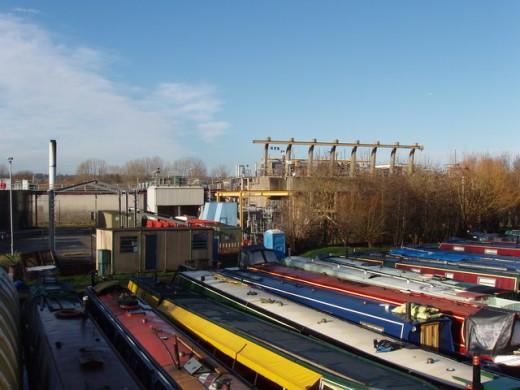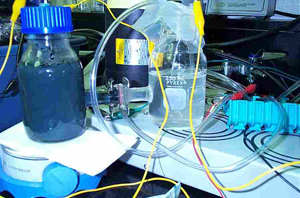Microbial fuel cells: wastewater to energy
Smelly, unsanitary sewage enters a wastewater treatment plant. Water clean enough to restore to a lake, river, or underground aquifer comes out. So does sludge. Sludge requires further processing and disposal. It can be composted, burned, sprayed on land, etc. Whatever the wastewater treatment plant ultimately does with its sludge is expensive and energy intensive. It has been estimated that American municipal wastewater treatment plants require 21 billion kilowatt hours of electricity just to process the sludge. Scientists have recently calculated that a different method of treatment, using microbial fuel cells, can not only minimize sludge, but generate electricity in the process.
The illustration below shows a British wastewater treatment plant burning sludge in order to produce electricity. All I know about it is the accompanying description on Flikr, so I don't know how much it generates in comparison to what it takes to pump and process the sludge for burning. But at least that plant doesn't have to pay the local utility for that much power.

Microbes, of course, have lived for eons. Microbial fuel cells depend on taking advantage of the natural processes by which they consume their food and produce their own waste matter, which can include electrons. These processes differ according to the presence or absence of air. In fact, anaerobic digesters have been used to produce and extract methane. That methane can be used just like natural gas for any purpose of natural gas, including generating electricity. The first study of the energy potential of wastewater, however, took place only in 2004. Also, standard anaerobic processes require and elevated temperature and therefore extra energy.
Microbial fuel cells work on an anaerobic process that works at normal temperatures. It is not necessary to heat them artificially even in winter. I will not attempt to explain the biochemical processes that take place within the cell, but basically the microbes have a happy feast in one part, called the anode. In the process, they consume the solid matter and excrete carbon dioxide, protons, and electrons. Under anaerobic conditions, there are several ways that they transfer electrons that the fuel cell collects. As in any battery, the anode, working together with a cathode, gives off electricity.
The water that comes out of the cell is potentially cleaner than water from a modern tertiary treatment system. And I have read about treatment plants that boast effluent that is safe to drink without further treatment. Where conventional treatments must consume a tremendous amount of electricity to deal with sludge, microbial fuels cells produce much less sludge and generate electricity.

As the cost of energy rises, the cost of present methods of wastewater treatment will become prohibitively expensive. Because microbial fuel cell technology is in its infancy, it will take a while to discover the most efficient designs that can be built on a scale suitable for use in actual wastewater treatment plants. I found the picture here on the Pennsylvania State University site. Another site, which has apparently been taken down, had 22 pictures of microbial fuel cells, presenting quite a variety of appearance. I gather that they are all rather small. A very useful research paper on using microbial fuel cells for wastewater treatment used one that has anode and cathode with a volume of only 350 milliliters each.
Once microbial fuel cells can be built large enough for actual use in wastewater treatment plants, and once they can be built in sufficient quantity for widespread use, it will become financially attractive to use them to replace current processes for the fuel savings alone. Will the wastewater treatment plant of the future become a profit center, selling the extra electricity it generates? Time will tell. It does seem safe to predict that, using microbes instead of coal to generate their electricity, wastewater treatment plants can help reduce both demand for electricity and the need for fossil fuels to produce it. We can't stop flushing energy down the toilet, but we can capture and use some of it!
Photo credits: Burning sludge © Copyright David Hawgood and licensed for reuse under this Creative Commons Licence. -- Microbial fuel cell Pennsylvania State University; research funded by the National Science Foundation
© 2011 David Guion






